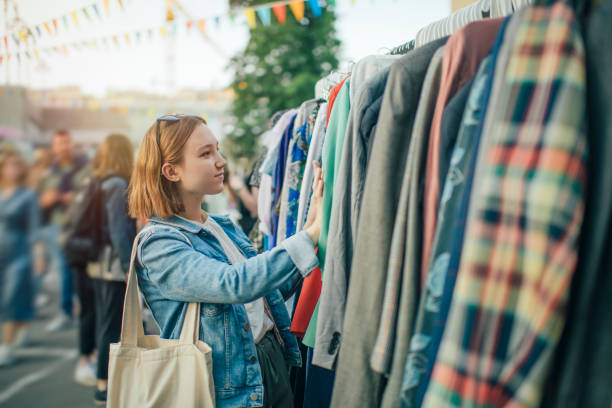The secondhand apparel market is expected to reach a valuation of USD 125.18 billion by 2034, growing at a remarkable CAGR of 11.1% through 2034. This rapid growth is primarily due to the rising popularity of secondhand clothing among the general public. Secondhand apparel is becoming increasingly popular because of its affordable price tag and superior quality, driving demand for pre-owned clothing. As a result, the market is experiencing significant expansion and is expected to continue growing in the near future.
The significant growth observed in the secondhand apparel industry can be primarily attributed to the preferences of younger consumers, particularly Generation Z and Millennials. According to a global survey, these cohorts emerged as the most willing demographic to purchase pre-owned clothing. This inclination is deeply rooted in their recognition of secondhand apparel as a cost-effective alternative and a more environmentally conscious choice.
Younger consumers are increasingly mindful of the environmental impact of their consumption habits, including fashion. The sustainability aspect of secondhand apparel resonates strongly with them, as it aligns with their values of lowering waste and underestimating their carbon footprint. By opting for pre-owned garments, they contribute to reducing textile waste and support the principles of a circular fashion economy.
Furthermore, affordability plays a significant role in driving the popularity of secondhand apparel among younger consumers. Many high-quality clothing items, including those from luxury brands, become more accessible through the secondhand market due to reduced prices. This accessibility allows individuals to access coveted styles and brands that may have been financially out of reach in the primary retail market.
The convergence of affordability and sustainability has led to remarkable growth in the secondhand personal luxury goods market. Younger consumers, drawn by the allure of luxury at a more attainable price point, are increasingly turning to pre-owned luxury items.
Key Takeaways from the Secondhand Apparel Market
- The United States secondhand apparel industry is projected to experience a CAGR of 2.6% through 2034.
- Japan’s secondhand apparel market is expected to demonstrate a rapid CAGR of 7.6% through 2034.
- The United Kingdom’s secondhand apparel industry is anticipated to witness a CAGR of 9.3% through 2034.
- The Indian secondhand apparel industry showcases a significant CAGR of 14.0% through 2034.
- The Chinese secondhand apparel market is expected to display a CAGR of 4.8% through 2034.
Competitive Landscape in the Secondhand Apparel Market
The secondhand apparel market is transforming through innovative business models, technological advancements, and strategic partnerships. Fashion brands are leveraging technology to improve the online shopping experience, attracting a wider audience. Online resale platforms and marketplaces use advanced algorithms and machine learning techniques to enhance product recommendations, personalize user experiences, and optimize inventory management. Clothing manufacturers are promoting circularity and sustainability through subscription-based rental services and initiatives like clothing resale and upcycling programs.
Enterprises in the secondhand apparel market are also forging strategic partnerships with fashion brands, retailers, and influencers to expand their reach and tap into new markets. Collaborations between resale platforms and established brands enable the resale of pre-owned designer clothing and accessories, attracting luxury consumers seeking value and sustainability.
The market players are reshaping the fashion industry landscape by championing sustainability, circularity, and inclusivity, paving the way for a more ethical, transparent, and resilient future.
Recent Developments in the Secondhand Apparel Industry
- At its flagship location in London, H&M, a Swedish clothing shop, introduced a new collection named “Pre-Loved” in October 2023. The collection comprises used women’s apparel. Action is being taken to improve the sustainability policies of fast-fashion retailers like H&M.
- Leading adolescent retailer Journeys, owned by Genesco and thredUP, introduced “Journeys Secondhand” in July 2023. This eco-friendly resale service lets users purchase gently used clothing and exchange it for Journeys shopping credit.
Complete Market Review: A Full Report Analysis
Who is Winning?
Key players in the secondhand apparel market are aiming for strategic collaborations and other marketing strategies to expand their business and attract a larger customer base.
Some of the key players present in the secondhand apparel market are
- Thredup Inc.
- The RealReal
- Poshmark
- Vinted
- Micolet
- Percentil.ma
- Thrift+
- Chikatex
- HunTex Recycling Kft
- EBay Inc.
- British Used Clothing Company
- A&E Used Clothing Wholesale
- Mobacotex
- Tradesy
- StockX
About Future Market Insights (FMI)
Future Market Insights, Inc. (ESOMAR certified, recipient of the Stevie Award, and a member of the Greater New York Chamber of Commerce) offers profound insights into the driving factors that are boosting demand in the market. FMI stands as the leading global provider of market intelligence, advisory services, consulting, and events for the Packaging, Food and Beverage, Consumer Technology, Healthcare, Industrial, and Chemicals markets. With a vast team of ~400 analysts worldwide, FMI provides global, regional, and local expertise on diverse domains and industry trends across more than 110 countries.
Contact Us:
Future Market Insights Inc.
Christiana Corporate, 200 Continental Drive,
Suite 401, Newark, Delaware – 19713, USA
T: +1-845-579-5705
For Sales Enquiries: sales@futuremarketinsights.com
Website: https://www.futuremarketinsights.com
LinkedIn| Twitter| Blogs | YouTube
